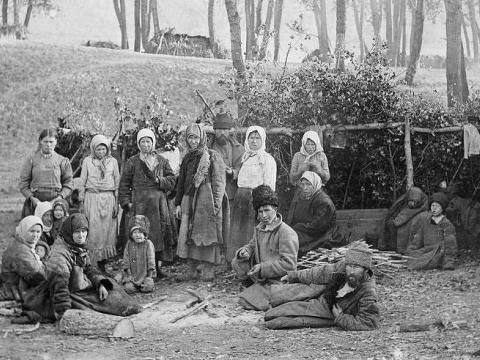A short history of an uprising by (mostly) Bulgarian peasants in the waning Ottoman Empire. The peasants fought to abolish their feudal duties and taxes, but many of their leaders were also motivated by a mix of national autonomy and Christianity. The revolt was defeated but outrage over the severe reprisals by the authorities forced the Ottoman Empire to back down and introduce limited land and tax reforms.

Bulgarian uprising (1850) Ever since the Turks conquered Bulgaria at the end of the 14th century, the local Slav and Christian population, undeterred by the stringent rule and bloody repression, kept revolting and staging armed uprisings. Whenever Turkey fought a war with any of the European Christian powers and was defeated, Bulgarians rose up. In late spring 1850, a delayed reaction to revolutionary events in central Europe occurred in the north-western part of Bulgaria.
Bulgarian peasants had all the time been opposed to the feudal oppression which, as practiced by the Ottoman regime, involved a direct robbery disguised as tributes levied by Turkish feudal lords. Bulgaria's first young intelligentsia strove to make Bulgarian peasants correlate the demand for abolition of primitive feudal oppression with the claim for autonomy for the Bulgars. It was too early at that time, in confrontation with the still prevailing Ottoman power, to envision the full freedom for Bulgaria.
After the Hungarian revolution had fallen, several thousand revolutionaries began arriving by August 21, 1849 in t he Turkish city and fortress of Vidyn in northwestern Bulgaria. There came almost a thousand Poles, several hundred Italians, and less than a hundred Germans. Among the revolutionaries were Lajos Kossuth, Josef Bem, and other Hungarian and Polish generals. On October 30, 1849, they began moving to another Turkish fortress, Shumla (today's Shumen). Contacts with interned soldiers of the Hungarian revolution, prominent politicians and generals among them, their independent and critical attitude to Turkish authorities, a possibility to communicate with the Poles due to language affinities, all encouraged Bulgarian leaders.
In 1849,in an area between the western part of the Balkan mountains and the Danube, preparations for an uprising commenced. Although appearing later as spontaneous, the uprising had been carefully planned and prepared. At the beginning of 1850, peasant representatives gathered in the Rakovitsa monastery and set the date of June 1, 1850 as the first day of fighting. Military leaders were appointed. The program of demands put forth to the Turkish authorities sought consent to the sale of land to individual villages and abolition of Bulgarian peasants' tributes to the Muslim feudal lords. All the Hattisherif decisions and generally all the Tanzimat acts were to be fully implemented.
The initial fights of the Bulgarian uprising took place between May 27 and June 8, 1850, but the principal actions, as planned, were carried out between June 1-12, 1850. About a thousand-strong peasant party, without firearms, led by Captain Kriztio, took the town of Lom. Soon, however, a battle with a well-armed Turkish detachment broke out near the town. The insurgents lost, Kriztio was killed, but the Bulgars did not scatter and, led by Ivan Kulin, set forth toward Belogradchik. Further four hundred volunteers joined them en route.
About three thousand insurgents commanded by Petko Marinov marched toward Vidyn to block the fortress. The regular Turkish army, however, defeated the insurrectionaries after a two-hour battle; the Bulgarian forces split up into smaller groups and scattered in various directions.
The longest operation of the Bulgarian forces took place near the town of Belogradchik. Several thousand volunteers who had only two-hundred guns between themselves blocked the town for ten days. When the regular Turkish troops, reinforced by bashibosouks, arrived from Vidyn, a whole-day battle ensued. The insurgents retreated to the mountains, some moving to Serbia; the Turks did not dare to pursue them.
The Bulgarian uprising involved a total of ten thousand Bulgarian peasants, about seven hundred being killed in combat. Appeals for help to Russia whose army was stationed in Wallachia, on the other bank of the Danube, was unsuccessful, since the tsar's army would never support the fight for peoples' freedom. The Serbian duchy also failed to assist the insurgents significantly. For their part, the Turks began a bloody vengeance. About three thousand peasants, mostly women and children, were slain. All Bulgars were killed in Belogradchik. Although the peasants sent a delegation to Istanbul to deliver the "Islozhene", the terror did not abate. Europe, however, witnessed the aftermath of the insurrection with a growing outrage. Bulgarian activists prepared a lengthy memorial in French and passed it to foreign diplomats. Diplomatic pressure on the Sublime Porte resulted in concessions. Principles of land management and the tax system were changed, families of the murdered Bulgarians were paid compensations. Although their effort ended with a defeat, the insurgents of northwestern Bulgaria won a partial victory as the agrarian relationships in the country changed. All that stimulated Bulgarians' political identity and agitation for independence. The Vidyn uprising of 1850 was a delayed echo of the European revolutions of the two preceding years.
Slawomir R.Kalembka
Bibliography
Dimitrov S., Vastanieto ot 1850 godina v Balgarija, Sofija 1972.
Dokumenti za novata istorija na balgarskija narod is venskite darzaven archiv 1830-1877, I, Sofija 1948.
Kasev D."Vastanieto na seljanite v Severozapadna Balgarija prez 1850 g. i negovite pricini" Istoriceski pregled, 1949/1950, No. 4-5.






Comments